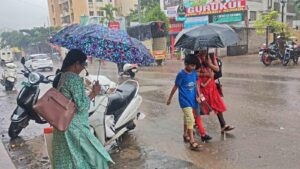Classical status for Marathi mere lip service by Shinde government: Academicians | Mumbai news

MUMBAI: Recently, Marathi, draped in a shimmering Paithani and exuding dignity, stepped into the hall of fame of classical languages. A formal announcement from the Centre came amidst the heat and dust of the legislative assembly polls prep.

While everyone celebrated the decision, it also sparked a debate in literary circles on a slew of issues germane to the central theme: a glorious future for Marathi and its ten crore-plus adherents spread across Maharashtra’s rugged terrain.
HT sought views from a cross-section of writers and academicians.
Promote dialects
Now that Marathi has been declared a classical language it’s time to face several bald truths. We Marathis have over the decades become indifferent to our mother tongue. While we shout from the rooftops about Marathi’s glorious past, we refuse to take the blame for our collective apathy for the language.
Our libraries are in poor condition and the publishing industry is in bad shape. I am told that a publisher isn’t willing to go beyond 500 copies of which the writer buys over a sizeable chunk, as gifts for friends.
We don’t have good research journals or magazines devoted to serious debate; nor do we come up with in-depth criticism of, for instance, Bhalchandra Nemade, Mahesh Elkunchwar or Vinda Karandikar, eminent Marathi writers who won accolades at the national level.
There were times when grandmother’s bedtime stories helped the young generation bond with books and Marathi language — its turn of phrases, songs and words. Today, families hardly have any time for storytelling.
Like all Indian languages Marathi too has an amazing treasure trove of ‘boli bhashas’, and each dialect acquires a new avatar every ten kilometers. For instance, the Agri ‘boli’ of Kalyan-Dombivli is different from the one spoken in Pen-Panvel. There should be more state-sponsored sub centres for the study of dialects, without, of course, impinging on the grammar of ‘pramaan’ (standard) Marathi.
Also, it’s time to set aside generous funds for a long-term translation project. A good translation of literary masterpieces, in both Indian and foreign languages, and books on science and technology will go a long way to empower Marathi.
— Neeraja, poet-writer, based in Mumbai, who heads the Sane Guruji translation centre in Raigad.
Improve Marathi-medium schools
The long-awaited inclusion of Marathi in the charmed circle of classical languages is doubtless a major decision for Maharashtra, its people and culture. However, only a practical outcome on ground will eventually validate the decision.
While academic studies of Maharashtra’s ancient traditions is welcome as it brings recognition to Marathi at the national level, immediate concerns about Marathi’s wellbeing merit greater attention.
For instance, the number of parents opting for English medium schools for their children has been escalating at an alarming rate in recent years. This stems from the popular perception, not entirely unfounded, that English brightens job prospects, and that Marathi medium schools lack infrastructure and quality.
However, the trend poses a grave threat to the very existence of Marathi and its role in homes and workplaces. Moreover, ignoring the urges of mother tongue eventually mauls the community’s ability to produce great literature and the arts.
Policy makers should take the Centre’s ‘classical language’ decision as a starting point, and work on a broader canvas. Secondly, those in power should keep away from patronage culture — awards and token gestures, etc. — and instead tap the intrinsic strength of Marathi to meet the challenges ahead.
While no one denies the uniqueness and historical value of Marathi, we need to go beyond cliches, and set down parameters to give a leg-up to Marathi medium schools, improve library systems, both physical and digital, set up research centres and update dictionaries.
Marathi sparkles with an inner glow thanks to scholars and saint poets, philosophers and pamphleteers, artistes and artisans. Restoring its pristine glory should be a collective effort.
We owe it to Marathi.
–– Ganesh Matkari, Mumbai-based litterateur and screen writer.
Revive the old texts
Marathi’s credentials are impeccable. It dates back to the Jnaneshwar-Mahanubhav era, and has thus created a myriad literary and cultural traditions over the centuries.
The classical language tag is a mere formality, a seal of approval. A language is known not only by her antiquity, but by a robust legacy it leaves behind for its children. Jnaneshwar and Tukaram have stood the test of time.
The Centre’s decision is likely to lead to a clutch of sarkari committees, release of funds and so forth. The state and its cumbersome bureaucratic machinery will do their job. However, literary bodies, research institutions, universities and translation centres should be roped in to give a thrust to Marathi.
Marathi has a formidable repository of manuscripts, ancient texts, monographs, correspondence, royal diktats, edicts and much more. We need to go through the wealth of written documents with a fine-tooth comb. The sooner we begin research work the better. They should be set up across the state.
Take, for instance, the literary works of Jnaneshwar and Tukaram, Maharashtra’s legendary saint poets. They have experimented with many forms and style, but we haven’t delved into their works with vigour and scholarship.
Let me take you back in time to the Tanjore court of king Sarfoji where a Marathi play, written and performed by local actors, was actually an amalgam of five languages. The play needs to be brought out of mothball laden boxes.
Sadly, we Marathis are splendidly indifferent to our culture and heritage. It appears that Maharashtra is mired in ennui. We should remember that low self-esteem can’t be cured by several hundred crores offered by the state. The onus lies with us — you and me— the inheritors of Marathi.
–– Pravin Dashrath Bandekar, Sahitya Akademi-winner and professor of Marathi, based in Sawantwadi, Konkan.
Can we teach AI in Marathi?
There is scarcely any doubt that the Centre’s decision is prompted by electoral considerations; the Maharashtra assembly elections are just a few weeks away. However, one must look at the sunnier side as well to get going on ‘Mission Marathi.’
First, we’ll have to create a pool of academicians to prepare text books in Marathi covering a wide expanse of knowledge, including aeronautics and AI, nuclear science and nano technology, philosophy and psychology, economy and environment and so forth.
It can begin with a small team of writers and expand thereafter in phases. We need science dictionaries to de-mystify global ideas and terms, and segue them into Marathi consciousness. Fortunately, we have good scholars in Maharashtra, who can undertake the task.
Second, the need of the hour is to equip Marathi with adequate tools and skills to face future challenges. I think Marathi students have talent and resilience to understand in their mother tongue the intricacies of higher themes in science and math.
A language evolves itself to keep pace with changing times. Marathi, armed as it has been for centuries with an incredible range of robust ‘boli bhashas’ (dialects), can recharge itself if backed by good planning and institutional framework.
Marathi has traversed a large swathe of India, thanks to wars and migration. It cast a spell on the upper plains of the Punjab and Sindh, and down South as well.
Today, Marathi schools, run by the local zilla parishads, wear a deserted look as parents opt for English medium schools. The outcome is chilling, as students who lack felicity and communication skills in English are led to alienation and loneliness.
The state government and the bureaucracy should utilise the Centre’s fund judiciously, and create an eco-system to take Marathi to the next level.
–– Ranganath Pathare, writer, Sahitya Akademi-laureate and academician, based in Sangamner, Ahmednagar district.
Crushed under poor self-esteem
The problem lies not with Marathi, but Marathis. Wracked by low self-esteem they tend to take a dim view of everything around them, including their mother tongue. Two Marathis see nothing wrong in conversing in Hindi or, if they belong to the upper class, in English.
Seventy seven years after Independence the burra sahib’s language is seen as symbol of prestige and clout. A well-educated Marathi is worried more about dotting the ‘i’s and crossing the ‘t’s than mastering the ‘rhasva-deergha’ of Marathi. Macaulay must be laughing heartily in his grave.
The situation is equally grim in Maharashtra’s heartland. Marathi schools are dying a slow death in the villages. A chain of English medium schools is doing brisk business in Marathwada, the region to which I belong, and which is known for its saint poets and writers.
While students are quick to understand the basic tenets of science and math when explained in Marathi, they find English pretty dense. Teachers who teach English are not fluent in the language.
Yet, parents are insanely obsessed with English medium schools. They fear that Marathi can’t bring their children good jobs. We as a community couldn’t infuse resilience into Marathi so that it could help its adherents earn livelihood is our failure.
Lulled into believing that language is about literature, we didn’t think of shaping Marathi for trade, technology and the corporate sector.
Those in power, whether the Union government or its state counterpart, will release 300 crore or more for the development of Marathi. However, of greater significance for ‘maai’ (mother) Marathi is how and when will her sons regain their lost pride and shed their prejudices.
— Dasoo Vaidya, poet and academician based in Aurangabad.




